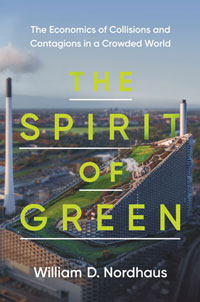The Spirit of Green: The Economics of Collisions and Contagions in a Crowded World

William D. Nordhaus
Princeton University Press
Princeton, NJ, 2021, 368 pp., $29.95
The Spirit of Green by William Nordhaus comprehensively tours the landscape of economics, ethics, and the environment. It is a discursive inventory of matters environmental, with eye-opening insights. His account of using lumens per hour as a proxy for productivity builds on the groundbreaking series of experiments he conducted in his 1994 paper. And he details the scope and limitations of green accounting, emphasizing the importance of good data to manage environmental resources and guide decisions.
Nordhaus puts a premium on objectivity. He eschews ideology in favor of evidence, reaffirming his long-standing belief that effective climate policy is “a question of balance.” Here too, he stakes his Goldilocks approach midway between the “far left” “deep green movement” and the profiteering “far right…muck brown” (as he puts it) approach.
Consciously steering clear of motivated reasoning on a contentious subject is refreshing and welcome. But by focusing mostly on backward-looking evidence, much of the analysis relates to marginal changes in the context of static market failures. Yet the big environmental questions of our time concern non-marginal transformations and potentially catastrophic systemic shifts. These include the collapse of fisheries, the dieback of tropical rain forests, ecosystem destruction, and runaway climate change—calamities that scientists believe might occur once irreversible thresholds are breached.
The same critique can be leveled at his assessment of the options available to fend off environmental crises. He rightly emphasizes the centrality of pricing damaging behavior in an efficient and nondiscriminatory manner, a message that has yet to make a tangible impact on US climate policy. But by mostly ignoring the theory of endogenous technical change he undersells the importance of driving innovation.
The author argues that emissions reduction is extremely expensive, costing “in the range of 2 to 6% of world income . . . to meet international targets.” He concedes that while “miraculous technological breakthroughs might conceivably be discovered that can reduce the costs dramatically, experts do not see them arriving in the near future.” But as his co-recipient of the Nobel Prize for economics Paul Romer notes, there is far more room to be conditionally optimistic about our ability to cost-effectively decarbonize the world’s economy.
Abatement costs are shaped by innovation. Once a globally scaled and integrated technology becomes sufficiently competitive, economies of scale in production and discovery allow it to undercut incumbents and alter the entire environment in which it operates. Nordhaus’s preference for a uniform global carbon price, rising with time, is premised on a static marginal abatement schedule whereby investors pick off the most cost-effective emissions reductions at the margin. But many economists argue that inducing innovation may in fact require front-loading a credibly high carbon price and focusing on the most expensive sectors to kick-start innovation where the potential for induced cost reductions is greatest.
This book is a rigorous and far-reaching introduction to environmental economics, yet The Spirit of Green could be less murky in color were it infused with more spirit of discovery.
Opinions expressed in articles and other materials are those of the authors; they do not necessarily represent the views of the IMF and its Executive Board, or IMF policy.









